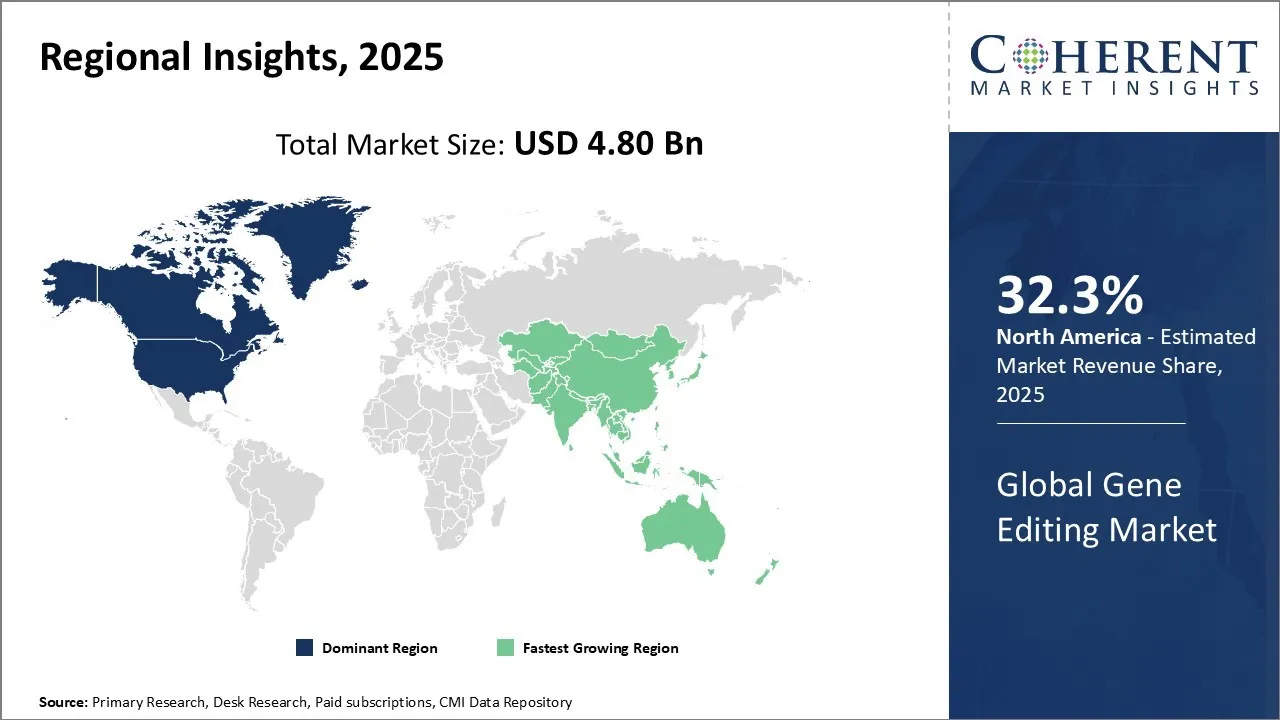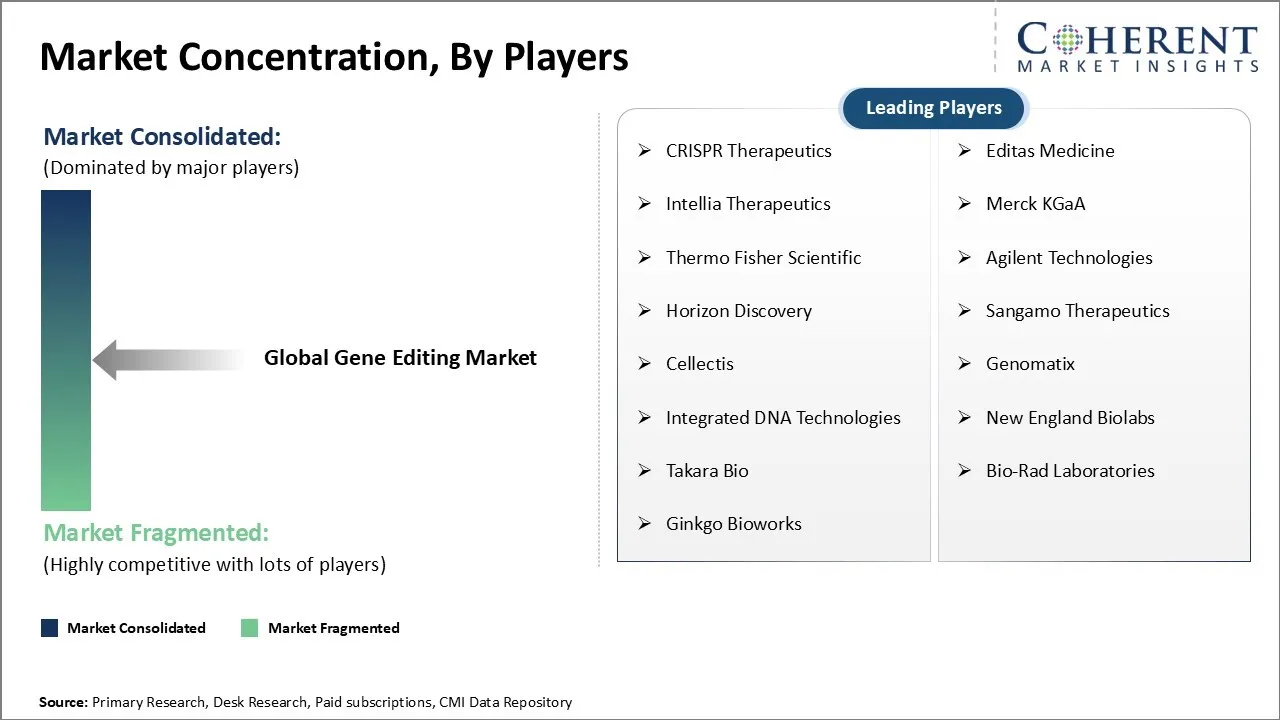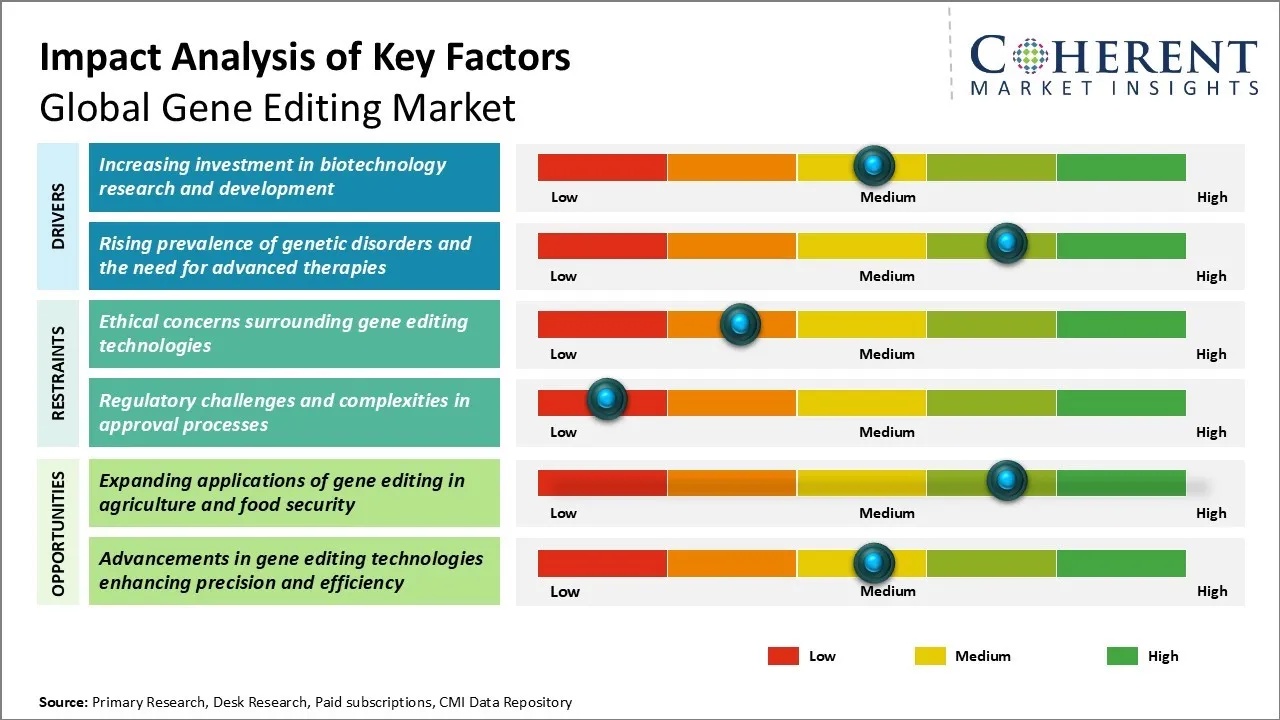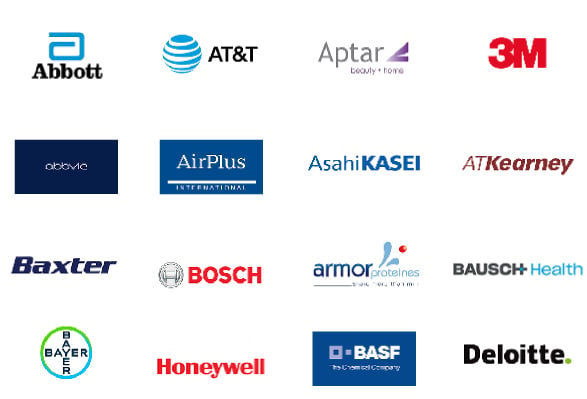The Global Gene Editing Market is estimated to be valued at USD 4.80 Bn in 2025 and is expected to reach USD 9.51 Bn by 2032, exhibiting a compound annual growth rate (CAGR) of 10.2% from 2025 to 2032.
Key Takeaways of the Gene Editing Market:
Market Overview:
The gene editing market is expected to witness high growth due to increasing investments from both private and public sectors. There is a rising focus on developing therapies for various genetic diseases along with their commercial applications in the biotechnology and agriculture industries worldwide. Advanced technologies, such as CRISPR/Cas9, have provided opportunities to manipulate DNA with high precision. Growing application areas such as genetic engineering in crops is another factor supporting the use of gene editing. However, strict regulations for their clinical usage could pose a challenge for market growth to some extent. If ongoing clinical trials demonstrate success and safety, it will help accelerate the product acceptance and commercialization of gene editing technologies.
Product Insights – Being Versatile Tools for Targeted Genome Manipulation, Kits Drive Adoption
In terms of product, the kits segment is expected to contribute the highest share of the market with 42.1% in 2025 owing to their ease of use and versatility. Gene editing kits provide researchers with all the necessary components and optimized protocols for performing genome edits in a wide range of cell and model organism types. The modular nature of kits allows them to be tailored for specific editing techniques like Clustered Regularly Interspaced Short Palindromic Repeat (CRISPR), Transcription Activator-Like Effector Nucleases TALENs, or Zinc Finger Nucleases (ZFNs). This helps lower the barrier to entry for labs seeking to introduce genome editing capabilities without extensive protocol optimization. Certain "all-in-one" kits have streamlined the process further by integrating nuclease expression vectors, repair templates, and selection markers. The availability of pre-designed and validated CRISPR guide RNA libraries targeting model organisms is another driver of kit adoption. Kits are attractive for their consistency and reproducibility relative to assembling components separately.
Technology Insights - A Revolution in Precision, CRISPR Leads Technology Uptake
In terms of technology, the Clustered Regularly Interspaced Short Palindromic Repeats (CRISPR) segment is expected to contribute the highest share of the market with 34.2% in 2025 owing to its unparalleled ease of use and versatility. Since the discovery that CRISPR elements could be repurposed for genome editing, it has revolutionized the field due to the simplicity of its editing mechanism. Researchers can create custom nucleases by fusing a CRISPR-associated protein to a short guide RNA strand designed to target a site of interest. This has advantages over older technologies like ZFNs and TALENs which require more complex engineering of DNA-binding domains. CRISPR also supports more flexible multiplexing through the use of several guides, enabling applications like knocking out whole gene families.
Application Insights – Cell Line Engineering Evolved as a Booming Field for Target Discovery and Validation
In terms of application, the cell line engineering segment is expected to contribute the highest share of the market with 41.2% in 2025 driven by the demand for tailored cellular platforms. As biotech enters an era focused on modality translation like cell and gene therapy, engineered cell lines play a central role across drug discovery and manufacturing platforms. Genome editing has transformed cell line development by enabling targeted modifications to accelerate the isolation of high-producing clones previously achievable only through serial random mutagenesis. It supports rational modification of cellular phenotypes including enhanced growth, productivity, protein folding, and secretion. Knock-in of fluorescent or selectable reporters is streamlining clone screening. CRISPR in particular has accelerated the development of isogenic cell panel models for validatory assays.

Need a Different Region or Segment? Customize now
North America Gene Editing Market Trends
North America’s dominance in the gene editing market with an estimated share of 32.3% in 2025 can be attributed to robust research infrastructure and the presence of major market players in the region. Countries like the U.S. have consistently increased funding for genomics research over the years, establishing the region as a global leader in developing advanced gene editing techniques.
Asia Pacific Gene Editing Market Trends
The Asia Pacific region is expected to exhibit the fastest growth with an estimated share of 26.6% in 2025, led by China, Japan, and India. Significant government investments to strengthen indigenous R&D capabilities and a large patient population are driving clinical applications of gene editing technologies. Countries like China have emerged as global innovation hubs, with companies developing novel solutions tailored for the local market.
Gene Editing Market Outlook for Key Countries:
U.S. Gene Editing Market Trends
The U.S. leads the gene editing market, driven by robust growth in the pharmaceutical and biotechnology sectors. Key factors such as technological advancements in genome editing, increasing product approvals, and heightened research and development activities contribute to the region's market dominance. In March 2021, the University of California scientists received the U.S. FDA approval for a clinical trial on gene correction therapy for sickle cell disease using patients' stem cells.
Canada Gene Editing Market Trends
Canada plays a significant role in driving the global gene editing market due to its advanced research infrastructure, government support, and focus on addressing rare genetic disorders. For instance, according to the April 2024 updated data of McGill University, the increasing prevalence of conditions such as Huntington's disease, which affects approximately 1 in 7,000 people in Canada, underscores the need for advanced therapeutic solutions.
U.K. Gene Editing Market Trends
The U.K. is a key driver of the global gene editing market due to its strong focus on genetic research and innovation, supported by government and institutional initiatives. For instance, according to November 2022 data from the United Kingdom Parliament, the prevalence of Huntington's disease, which affects approximately 8,000 people with an estimated 32,000 at risk, highlights the need for advanced therapeutic approaches.
Germany Gene Editing Market Trends
The Germany gene editing market achieved substantial revenue in Europe, driven by the presence of leading global companies like Merck KGaA and QIAGEN, which provide genome editing products and services. Collaborative partnerships and strategic alliances among key players have bolstered their market presence both nationally and internationally, contributing to the country's revenue growth.

Get actionable strategies to beat competition: Request sample copy
Top Strategies Followed by Global Gene Editing Market Players:
Emerging Startups - Gene Editing Industry Ecosystem
Key Developments:
Gene Editing Market Report Coverage
| Report Coverage | Details | ||
|---|---|---|---|
| Base Year: | 2024 | Market Size in 2025: | US$ 4.80 Bn |
| Historical Data for: | 2020 To 2023 | Forecast Period: | 2025 To 2032 |
| Forecast Period 2025 to 2032 CAGR: | 10.2% | 2032 Value Projection: | US$ 9.51 Bn |
| Geographies covered: |
|
||
| Segments covered: |
|
||
| Companies covered: |
CRISPR Therapeutics, Editas Medicine, Intellia Therapeutics, Merck KGaA, Thermo Fisher Scientific, Agilent Technologies, Horizon Discovery, Sangamo Therapeutics, Cellectis, Genomatix, Integrated DNA Technologies, New England Biolabs, Takara Bio, Bio-Rad Laboratories, and Ginkgo Bioworks |
||
| Growth Drivers: |
|
||
| Restraints & Challenges: |
|
||
Uncover macros and micros vetted on 75+ parameters: Get instant access to report

Discover market dynamics shaping the industry: Request sample copy
Market Driver - Rising prevalence of genetic disorders and the need for advanced therapies
A key market driver has been the growing burden of genetic diseases worldwide. Some of the common genetic conditions include cystic fibrosis, sickle cell disease, Duchenne muscular dystrophy, and several types of cancer. Their prevalence has been steadily increasing with the changing demographics as well as rising awareness levels among people. Conventional forms of treatment available are limited and do not effectively address the root cause of such inherited diseases. Gene editing holds promise for developing potential cures by directly modifying the defective genes responsible. For instance, in January 2021, researchers at the National Institutes of Health have discovered LINKED syndrome, a genetic disorder caused by mutations in the OTUD5 gene. OTU refers to the ovarian tumor domain. This mutation disrupts a key process in early development, leading to issues with the brain, heart, and facial structure.
Market Challenge - Ethical concerns surrounding gene editing technologies
Gene editing technologies have posed some significant ethical concerns which has challenged the growth of the global gene editing market. One of the major areas of concern has been with regards to altering human embryos and germlines. While gene editing offers possibilities for treating many genetic conditions, there are risks of intended or unintended off-target mutations which can be passed on to future generations. There are also debates around who should have access to gene editing technologies and whether it would increase social inequalities. Addressing these ethical concerns and regulating the technologies appropriately would be crucial to gain wider public acceptance and trust which is important for the long term sustainable growth of this market. Extensive research is still needed to fully understand the health risks and ensure gene editing is done safely and ethically.
Market Opportunity - Expanding applications of gene editing in agriculture and food security
One of the major opportunities for the global gene editing market lies in the expanding applications of gene editing in the agriculture and food security sectors. Gene editing technologies allow more precise modifications of plant genomes compared to traditional methods and can help address many challenges relating to crop yields, resilience to climate change, and disease resistance. This can play a key role in sustainably meeting the growing demands for food of the rising global population. By modifying crops to be more nutritious, beneficial traits can also be imparted which can help address issues relating to malnutrition. Furthermore, gene editing also enables more efficient breeding of livestock with improved productivity and disease resistance. As more commercialized applications emerge in coming years, it has the potential to significantly boost farm incomes and enhance global food security, creating extensive growth opportunities for players in the gene editing market.
Share
Share
About Author
Abhijeet Kale is a results-driven management consultant with five years of specialized experience in the biotech and clinical diagnostics sectors. With a strong background in scientific research and business strategy, Abhijeet helps organizations identify potential revenue pockets, and in turn helping clients with market entry strategies. He assists clients in developing robust strategies for navigating FDA and EMA requirements.
Missing comfort of reading report in your local language? Find your preferred language :
Transform your Strategy with Exclusive Trending Reports :
Frequently Asked Questions
Joining thousands of companies around the world committed to making the Excellent Business Solutions.
View All Our Clients
US Reciprocal Tax Impact Analysis On Gene Editing Market
Stay updated on tariff changes with expert insights and timely information